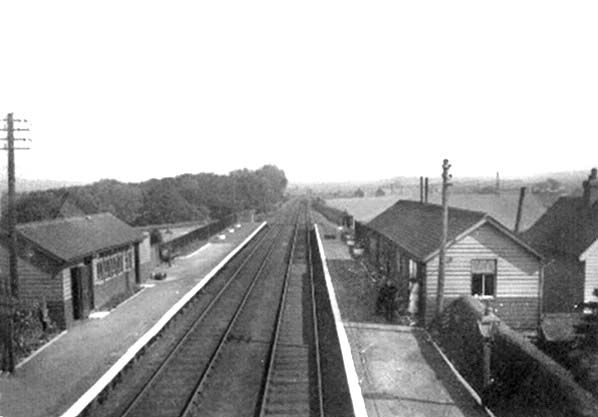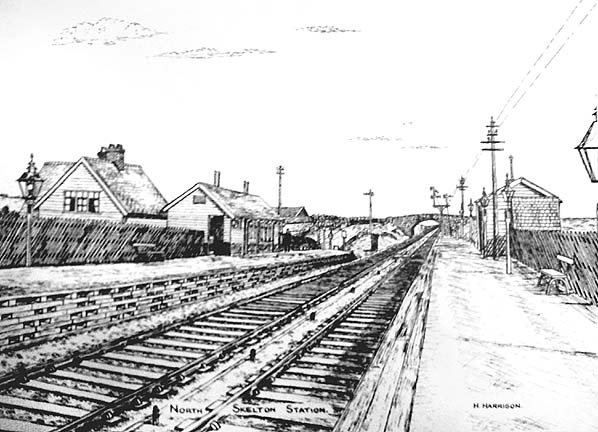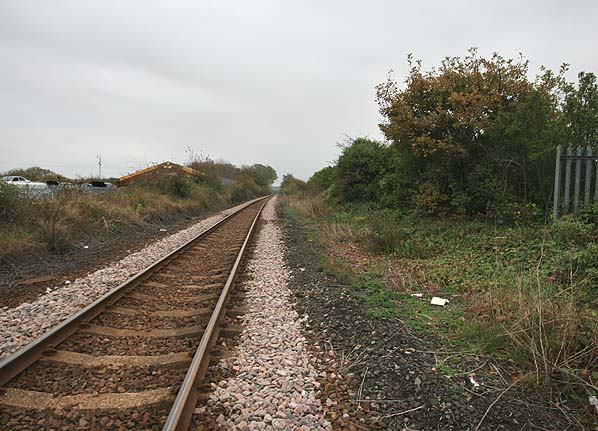Notes: North Skelton first opened to goods traffic on 1st April 1875 but a passenger station wasn't provided until 1st July 1902. The station had two platforms serving a double track. A timber waiting room and booking office was provided on the 'up' (Saltburn) platform with the Station Master’s house to the rear. The 'down' platform had a timber waiting room and a signalbox at the south end of the platform controlling two sidings on the down side of the line running behind the station; one served a goods shed. The platforms were connected by a footbridge.
The station closed on 15th January 1951 due to a shortage of coal but reopened for the 'summer season' on 18th June 1951 and closing permanently to passengers on 10th September 1951. The station retained its goods service until 1st February 1952. A private siding at the station reopened in October 1956, finally closing 21st January 1964. Click here for a more detailed history of North Skelton Station.
BRIEF HISTORY OF TEESIDE - WHITBY VIA THE COAST
Trains from Teesside to Whitby started operation on 3rd December, 1883 with a northern terminus at Saltburn. Trains for Whitby Town reversed at Saltburn West Junction to allow them to take the extension line from Saltburn to Brotton and thence follow the coastal line to Whitby through Loftus which up to then had been a terminus.
On 16th July 1885 the line from Whitby to Scarborough was opened so allowing some trains to run through to Scarborough. These trains called at Whitby West Cliff which was connected to Whitby Town by a shuttle service.
 |
In the summer of 1933 the northern terminus was changed to Middlesbrough and trains were then routed by way of Nunthorpe, Guisborough and Boosbeck to meet the original route at Brotton. A reversal was required on this route at Guisborough where rules were relaxed and trains of up to seven coaches in length were propelled in and out of the |
station which was at the end of a spur. Occasional summer trains would make Brotton via Redcar and the Saltburn extension.
Closure of the railway started pre Beeching with the Brotton to Saltburn section closing to passengers on 6th September 1957, Whitby West Cliff to Loftus closing to all traffic on 3rd May 1958, Loftus to Boosbeck closing to passengers on 30th April 1960 and the section from Boosbeck to Guisborough closing to all traffic on the same day. The line from Boosbeck to Brotton was closed completely on 12th September 1964.
The line remained open for goods from Saltburn West Junction through to Skinningrove and following the opening of a potash mine at Boulby the line was reinstated for the carriage of minerals between Skinningrove and Brotton from 1st April 1974.
The coastal rail link between Teesside and Whitby used a number of pre existing railway routes which had been constructed primarily with the ironstone mining activities as their main motivation. The individual lines are described below:
GUISBOROUGH - BROTTON - SKINNINGROVE (The Cleveland Railway route)
In 1862 the Cleveland Railway were pressing eastwards from Guisborough with the construction of their mineral railway and had reached Boosbeck which was quickly opened to traffic. By 1865 the Cleveland Railway had extended their line from Boosbeck to Brotton with goods traffic using it from 23rd February of that year.and by April goods traffic was working to Skinningrove. On 30th June 1865 the railway was absorbed into the North Eastern Railway.
SALTBURN - BROTTON (The Saltburn Extension) & SKINNINGROVE - LOFTUS
The 1865 Act authorised the North Eastern Railway to build a railway from Saltburn to Brotton in order to allow ironstone from the mines in the Brotton and Loftus areas to travel directly to the various works on the Tees east of Middlesbrough. The new line included the impressive Upleatham viaduct, designed by T.E. Harrison, with eleven arches, 783 feet in length and 150 feet high situated on the southern outskirts of Saltburn. Also authorised in this Act was the Priestcroft Curve which branched from the new Saltburn – Brotton line near North Skelton to connect with the Brotton to Guisborough route of the old Cleveland Railway. Also authorised in this act was the completion of the railway as far as Loftus so connecting the town with Saltburn, Guisborough and Middlesbrough. This necessitated the construction of a large curving viaduct over the Kilton Valley consisting of iron girders supported by twelve stone piers carrying the railway at a maximum height of 150 ft above Kilton Beck. In 1911 mining activity resulted in the undermining of the viaduct foundations and it was necessary for the line to be closed here for two years whilst the viaduct was buried in spoil from local mines. An embankment was formed and the line was reopened in 1913. Passengers were conveyed to and from Loftus and Skinningrove by road and mineral trains from the Loftus area reached Teesside via Whitby, Grosmont and Battersby.
In order for trains to reach the mines and gasworks below the village of Carlin How a zig zag was built; a formation most unusual for a British railway. The branch started north of Skinningrove station and ran for about ¾ mile at about 1 in 37 down into the valley before ending in a reversing neck below Kilton Viaduct. The second leg was much steeper at 1in 28 ending in another reversing neck from which trains could proceed along the valley floor to the various sidings.
On 1st July 1872 the line from Saltburn to Brotton was opened to goods traffic and on 1st April 1875 a passenger service was introduced between Saltburn and Loftus calling at Brotton and Skinningrove. By 1878 the Priestcroft curve was opened joining Boosbeck to North Skelton (no passenger station here yet) so allowing traffic from the Guisborough direction to run directly to Saltburn. Passenger trains between Guisborough and Saltburn started on 1st November 1878 and ran via Boosbeck station which was opened on the same day. Many of these trains ran to Saltburn via Brotton necessitating three reversals; at Hutton Junction, Guisborough, at Brotton and at Saltburn West Junction. Some services reached Saltburn directly by the Priestcroft curve although regular passenger workings using the curve had ceased by 1918. The Guisborough – Brotton – Saltburn – Loftus services were obvious candidates for NER push-pull operation; LNER Steam Railcars and later the BR DMUs were used to advantage here.
On 1st July 1902 North Skelton station was opened and remained in use until 1951.
On 6th September 1957 the Saltburn West Junction to Brotton line was closed to passengers but remains open for freight to this day.
Following the demise of the Loftus – Whitby service in 1958, Loftus again became a terminus with passenger trains running to Middlesbrough via Guisborough until 30th April 1960. Goods facilities here came to an end on 10th August 1963.
The line was singled and reopened beyond Skinningrove to Boulby on 1st April 1974. It remains open and carries mineral traffic from Boulby Mine and steel from Skinningrove.
Sources:
- Railways around Whitby (Vols. 1 and 2) – Martin Bairstow
- The Whitby, Redcar and Middlesbrough Union Railway by K. Hoole
- Regional History of the Railways of Great Britain – Vol. 4 The North East by K. Hoole
- Railway Memories No 18 – Cleveland and Whitby – Stephen Chapman
Tickets from Michael Stewart, all un attributed photographs received from Neil Cholmondeley
Further reading: Railways Around Whitby Volumes One and Two written and published by Martin Bairstow. ISBN 978-1-871944-34-1
To see other stations on the Saltburn - Whitby line click on the station name: North Skelton, Brotton, Skinningrove, Loftus, Grinkle, Staithes, Hinderwell, Kettleness, Sandsend & Whitby West Cliff. See also Boosbeck & Guisborough
See also Boulby Mine |





 Home Page
Home Page 








